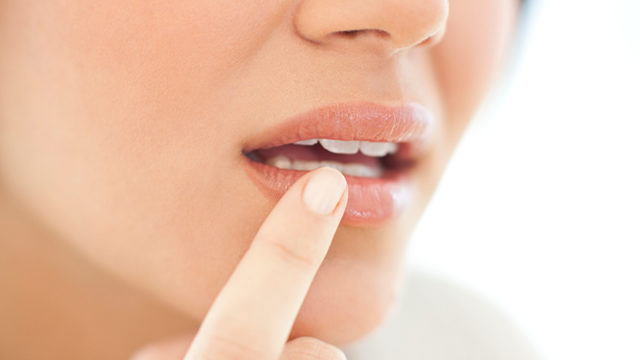
Herpes labialis, commonly known as cold sores or fever blisters, is a type of infection by the herpes simplex virus that affects primarily the lip. Symptoms typically include a burning pain followed by small blisters or sores. The first attack may also be accompanied by fever, sore throat, and enlarged lymph nodes. The rash usually heals within 10 days, but the virus remains dormant in the trigeminal ganglion. The virus may periodically reactivate to create another outbreak of sores in the mouth or lip. You won't usually have any symptoms when you first become infected with the herpes simplex virus (the primary infection). An outbreak of cold sores may occur some time later and keep coming back (recurrent infection). However, if the primary infection does cause symptoms, they can be quite severe. Herpes simplex virus primary infection In children Symptoms of the primary infection are most likely to develop in children younger than five years old. Symptoms include: swollen and irritated gums with small, painful sores in and around the mouth – this is known as herpes simplex gingivostomatitis sore throat and swollen glands producing more saliva than normal high temperature (fever) of 38C (100.4F) or above dehydration feeling sick (nausea) headaches Herpes simplex gingivostomatitis usually affects young children, but adults can also develop it. It can last 7 to 14 days, with the sores taking up to three weeks to heal. However, gingivostomatitis doesn't usually recur after the primary infection. In adults Primary herpes simplex viruses are rare in adults, but the symptoms are similar to those experienced by children. You'll usually have a sore throat with or without swollen glands. You may also have bad breath (halitosis) and painful sores in and around your mouth. These can develop into ulcers with grey or yellow centres. If you develop the herpes simplex virus at an early age, it may be triggered periodically in later life and can cause recurring bouts of cold sores. After the primary infection, the symptoms are usually reduced to just the cold sores themselves. Recurrent infections (cold sores) Recurrent infections usually last for less time and are less severe than the primary infection. The only symptom is an outbreak of cold sores, although you may also have swollen glands. An outbreak of cold sores usually starts with a tingling, itching or burning sensation around your mouth. Small fluid-filled sores then develop, usually on the edges of your lower lip. If you have frequent recurrent infections, you may develop cold sores in the same place every time. They may grow in size and cause irritation and pain. Initially, they may ooze before crusting or scabbing over within 48 hours of the initial tingling sensation. A cold sore usually passes through several stages: Tingling and itching. Many people feel an itching, burning or tingling sensation around their lips for a day or so before a small, hard, painful spot appears and blisters erupt. Blisters. Small fluid-filled blisters typically break out along the border where the outside edge of the lips meets the skin of the face. Cold sores can also occur around the nose or on the cheeks. Oozing and crusting. The small blisters may merge and then burst, leaving shallow open sores that will ooze fluid and then crust over. Diagnosis Your doctor can usually diagnose cold sores just by looking at them. To confirm the diagnosis, he or she may take a sample from the blister for testing in a laboratory. Treatment Cold sores generally clear up without treatment in two to four weeks. Several types of prescription antiviral drugs may speed the healing process. Examples include: Acyclovir (Xerese, Zovirax) Valacyclovir (Valtrex) Famciclovir (Famvir) Penciclovir (Denavir) Some of these products are packaged as pills to be swallowed. Others are creams to be applied to the sores several times a day. In general, the pills work better than the creams. For very severe infections, some antiviral drugs can be given with an injection. Things you can do yourself Cold sores take time to heal and they're very contagious, especially when the blisters burst. Important!!! Do not kiss babies if you have a cold sore. It can lead to neonatal herpes, which is very dangerous to newborn babies. Do eat cool, soft foods wash your hands with soap and water before and after applying cream avoid anything that triggers your cold sores use sunblock lip balm (SPF 15 or above) if sunshine is the trigger take paracetamol or ibuprofen to ease pain and swelling (liquid paracetamol is available for children) – do not give aspirin to children under 16 drink plenty of fluids to avoid dehydration Don't do not kiss anyone while you have a cold sore do not share anything that comes into contact with a cold sore (such as cold sore creams, cutlery or lipstick) do not touch your cold sore (apart from applying cream) do not rub cream into the cold sore – dab it on instead do not eat acidic or salty food References: https://en.m.wikipedia.org/wiki/Herpes_labialis https://www.mayoclinic.org/diseases-conditions/cold-sore/symptoms-causes/syc-20371017 https://www.nhs.uk/conditions/cold-sores/ By Mehdiyeva B.
If this page is in your subscriptions, then it will be removed. You will not see this page. If you want to unblock a user, go to the settings, the list of blocked users and click unblock